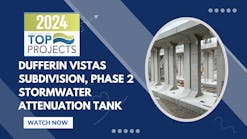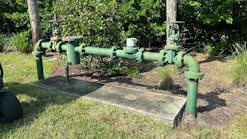Brant Keller learned a few things during his past life in the private sector that he cannot overemphasize to public stormwater utility advocates. “What I learned in sales is that you have to create a need,” explains Keller, whose unbridled excitement for the stormwater utility concept comes through even on a long-distance telephone call halfway across the country.Keller, the public works director for the city of Griffin, GA, says stormwater utility backers must employ the very same strategies and tactics that highly successful sales pros use. That means developing a white-hot passion for the mission and all associated tasks, and becoming a relentless sales machine. Yes, Keller says, public utility administrators and their advocates need to sell their product.As the old saying goes, Keller doesn’t just sell the steak; he sells the sizzle. It’s the only way, he insists, to break through to customers who feel overtaxed and, sometimes, underserved by local government.“Utilities are the worst at promoting their services. That’s been true for 200 years. Police and fire do it well, but engineers communicate horizontally, not vertically,” Keller says. “If you’re not marketing the program every day and showing people where the money is going and where the rubber meets the road, you’re setting yourself up for failure.” Worth a Thousand WordsOne way that Keller educated citizens about the need for the first stormwater utility in Georgia was through images. If a picture is worth a thousand words, Keller’s photos of Griffin’s flood-prone spots spoke volumes about the need for a stormwater utility at a time when he was still selling the concept to his bosses at City Hall.That one-man crusade underscores a common denominator he discovered when he wrote his doctoral dissertation on the subject: Stormwater utilities are almost always the product of an individual or individuals driven by sheer willpower to see the idea become a reality. Seventy-eight percent of the time, that person is “a professional with a passion.” Nearly as often–70% of the time–the project champion is a private citizen. In 61% of the stormwater utilities Keller studied, the prime mover was an elected official.Keller also spoke to anyone and everyone he could about solutions to the varied stormwater issues facing the city of 23,500, located about 25 miles south of Atlanta. Griffin’s top 50 utility customers received one-on-one visits from Keller. When the executive director of the local hospital initially balked at the idea of a stormwater utility fee, Keller pointed out the real possibility that a speeding ambulance could hydroplane out of control in front of a nearby elementary school during frequent street flooding. When meeting with a business owner concerned about his employees’ quality of life, Keller reminded him of the inconveniences caused every time 6 inches of storm runoff surrounded the firm. “My sales experience was definitely a plus,” he acknowledges.Keller says he began to consider the stormwater utility approach in 1994 when he realized Griffin would be covered under the National Pollutant Discharge Elimination System (NPDES) Phase II permitting programs. He turned to the Florida Association of Stormwater Utilities and other sources for information as he explored alternative funding sources to finance the capital improvement and operating expenses he knew were on the budget horizon. Still, making the “sale” was anything but simple as officials expressed concerns about the legality of a municipal stormwater utility. By mid-1997, Keller recalls, “I said, ‘Enough is enough.’ I went to the commission and said we had to move forward.”City commissioners approved $108,000 to fund a study of the proposed system and later $120,000 to convert the city’s billing system. Keller also worked to secure flood-mitigation grants from the Federal Emergency Management Agency. Griffin had state and federal loans totaling $3.9 million in hand when the utility was launched.Keller, a big believer in the sales philosophy of “show, don’t tell,” immediately began to create a brand for the utility. “We put our logo on everything–vehicles, stationery, offices, watershed signs–two years before the public even saw us build anything.”The showing never ends. Today, the utility’s Web site (www.griffinstorm.com) shows off public support by including testimonials from satisfied customers. Scott Bryant, P.E., manager of the stormwater utility in Greensboro, NC, follows that strategy by implementing a tactic of “balancing quick wins with thoughtful planning.”Bryant was hired by Greensboro after working as a consulting engineer to help establish the stormwater program and utility. He recently presented a paper at StormCon ’04 in Palm Desert, CA, in which he noted, “People in the community want to see tangible benefits from the new stormwater utility and program. It’s a good idea to ensure that the utility directs reasonable resources toward early improvements of known past problem areas and a probable ‘backlog’ of drainage concerns. Low-hanging fruit, quick wins, however you choose to describe it–showing improvements ‘on the ground’ will help solidify public support for the program.”There’s plenty of proof that a recipe of competence mixed with equal parts of good old-fashioned salesmanship and a passion for results can pay big dividends. In five years, the city of Griffin stormwater utility has been honored with the following awards:A 2003 Clean Water Partner Award from EPAA 2003 “Award of Recognition” from the American Public Works AssociationGeorgia’s first stormwater utility Innovation Award from the National Association of Development Organizations for the utility’s use of stormwater geographic information system (GIS) mapping, bacteria tracking, and drainage modelingThe first-ever “Best Stormwater Program” award from the Georgia Water & Pollution Control AssociationA 2001 Community Watershed Leadership Award from EPA Region 4 for the utility’s efforts in furthering the protection and restoration of the Southeast’s water resourcesA 2000 Engineering Excellence Award from the American Consulting Engineers Council for the North Griffin Detention Pond projectSuccess is being seen in Greensboro; Columbus, OH; Tampa, FL; and other communities across the nation. In fact, Hector Cyre, a Kirkland, WA, consultant, believes the “gestation period” for such replication is about three to five years in any particular part of the country. Cyre has been in on the ground floor of dozens of projects since leading the formation of the city of Bellevue, WA, stormwater utility in 1974. He notes many things have changed in the 30 years since then. “In 1974, there were two public stormwater utilities. In 1980, there were maybe a dozen. By 1990, there were perhaps 100, with a lot of those in Washington, Oregon, and Florida,” he explains. “Then it really started to take off. In 2000, my guess is there was something on the order of 400 across the country, and that may be a little low. I’m personally aware of 45 different communities that are in the process [of creating stormwater utilities] right now, though I’m certainly not involved in all of those projects.”Cyre predicts the focused, municipal approach to stormwater management will make quantum leaps in the next 30 years–both in sheer numbers and results. He’s seen and helped the concept leapfrog from Washington and Oregon to Colorado and Utah, to Florida, Georgia, and North Carolina, over to Kentucky and Ohio, and into other states.“Looking at the gestation period and knowing that others are going to start piling on as they see the results from other communities, there’s enough of a base that there will probably be 2,000 [stormwater utilities] by 2010.”Cyre offers another prediction. “You’re going to see many more cases of collaboration between government bodies and cooperative programs, whether through watersheds or intergovernmental agencies or whatever, especially with the federal emphasis on managing watersheds,” he says.Dirk Brown, manager of the Columbus, OH, stormwater utility, notes that officials in the area have mulled over the watershed approach to stormwater management, including the question of whether the creation of one utility is the best solution. “Water doesn’t know or appreciate political boundaries,” he says. “For us, it seemed like a very complicated job to get smaller municipalities to formally interact and divide up responsibilities and was more of a hurdle than anyone has wanted to tackle so far.”However, Brown notes that the city is working to further the watershed approach informally. The Columbus staff provides advice to Franklin County and several Ohio communities. Neighboring municipalities have made use of the Columbus utility’s publications too. “Everyone has their own needs, but we don’t need to reinvent the wheel,” he says.Bryant maintains that another key ingredient to successful surface-water-quality management is to “get the point- and nonpoint-[pollution-]source people talking, whether it’s done formally or informally.”He adds, “In Greensboro, we don’t look at things as a ‘wastewater project’ or a ‘stormwater project,’ for example. We look at local watersheds and develop as comprehensive an approach as possible to managing water resources and related environmental issues. For a very simple example, take the issue of trash and floatables. The city removes tons of trash every year from the MS4 [municipal separate storm sewer system] and receiving waters. Littering is a public-awareness issue. The watershed approach is the best way to manage those issues, because it often entails a multijurisdictional approach. We recently helped form the Piedmont Triad Water Quality Partnership, a regional collaborative public-education program among multiple local jurisdictions designed to address surface water quality, with pollution prevention as a primary goal.”Cyre says the pattern is for stormwater utilities or programs to take root in affluent suburbs with strong growth and energetic managers. “Look at who’s interested in urban planning: It’s the people in growing communities, and water resources are one component of that planning. Typically, the management team in place is proactive about problem solving. They have stormwater problems they want to solve and they also want to avoid creating more problems. The older, central cities then gravitate toward the [same approach] and then it filters down to smaller communities.”The Big PictureCyre concurs that Keller’s method in selling the public on the stormwater utility approach was an indispensable step in its genesis, but he also emphasizes the importance of communicating the big picture.It’s important to recognize that different communities have different needs, he says. In Bellevue, the issue was environmental protection under aggressive growth conditions. Tulsa, OK, had endured fierce flooding that claimed 14 lives when city officials turned to Cyre. Street flooding and quality-of-life issues were key concerns in Griffin when Keller called on Cyre’s expertise with billing and action plans back in 1997. The utility, Cyre notes, is a means to an end; effective management of stormwater is the real goal. In this context, Bryant also advocates the development of a sound vision for the stormwater organization, one that is founded in genuine core values and core purpose or meaning while also focused on striving for tangible goals that will protect and improve the community’s quality of life.“At the end of the day, it’s all about the water. That’s where I came into it with my coastal zone background and that’s what I remain convinced it’s all about: the water. Drinking water, sanitary sewers, stormwater–the common denominator is water,” Cyre says. “Stormwater has been excluded from the club for years. There are a lot of people who refer to stormwater as the redheaded stepchild at the family picnic. Frankly, that’s not giving enough regard to redheaded stepchildren.”He believes that attitude is about to change dramatically because people are beginning to understand and accept astronomer Carl Sagan’s point that it takes a miraculous set of circumstances for water to exist–and it does so in an “extraordinarily thin envelope.”As Cyre observes, “Water boils at 212 degrees. It evaporates at a lot less than that. It freezes at or below 32 degrees Fahrenheit and melts back to liquid form at that temperature. The environmental circumstance on the Earth allows water to exist in all three forms. That’s the basis of life as it exists on Earth. It is the fundamental element and we’re finally starting to grasp that. So, it’s not surprising that we’re starting to integrate all the elements together: stormwater, floodwater, groundwater, drinking water, agricultural use, coastal water resources–everything.”Getting the Ball RollingIn the late 1960s, Bellevue was beginning to address stormwater issues. The city’s population had soared from 5,500 at incorporation in 1955 to more than 61,000 in 1970, due in large part to a 1968 annexation that elevated the city to the fourth largest in Washington. A group of citizens voiced concerns that aggressive development was adversely affecting the community’s numerous salmon-spawning streams with erosion, silt, sedimentation, and pollution. The city council appointed a citizens committee to propose a solution. The result was a stringent erosion-control ordinance.The ordinance also created a stormwater management utility. Cyre had previously worked with Bellevue to secure economic development grants and landed the job based on his experience with startup projects. In 1974, he set about the task of turning an innovative yet unproven idea on paper into a functioning governmental entity that collected fees and produced measurable results in return. “We really put the hammer down on development impacts, but quickly we knew we couldn’t keep that up if others around us didn’t follow, so we did a lot of proselytizing,” Cyre recalls.By 1978, he was spending up to 25% of his workweek responding to questions and helping officials in Vancouver in Clark County, WA; Tacoma in Pierce County, WA; and King County, WA, as they struggled to implement utilities in their own communities. That’s when he struck out on his own, initially consulting for Pacific Northwest cities and counties; the City of Tampa, FL; and other clients to develop appropriate strategies and infrastructure to meet communities’ unique needs. He notes that getting the funding source right is often the difference between a smooth start and contentious litigation initiated by residential, commercial, or nonprofit customers.Funding Fuels ProgressCyre and others note the utility model provides a stable, dedicated funding source that general fund line items rarely match. “If a politician comes into office and cuts taxes and a project is just getting started, it might not get finished if the money is coming from the general fund,” Keller explains.Brown says the value of such stability should not be underestimated. With the demands of the NPDES permitting process and a substantial backlog in stormwater drainage complaints, a city without steady funding “is always behind the eight ball.”Like Keller, Bryant advocates establishing a billing system based on impervious surface area with residential, business, educational, nonprofit, and religious entities all paying an equitable share. In Greensboro, the utility has a three-tier fee structure that bills the average homeowner $2.70 per month, homes with lower levels of impervious area $1.50 a month, and properties with the largest footprints $3.90 monthly. Using what he calls the “Big Mac analogy,” Bryant tells residential customers, “Wouldn’t you be willing to give up just one of those great sandwiches a month to put a good stormwater management system in place?” The idea of each person paying a relatively small fee that contributes real and genuine value to the community is accepted over time by most. Years down the road, especially in the areas of recent and newly forming utilities, the idea of the stormwater utility will be much more commonplace and accepted as a vital part of the community. While recommending implementation of fee-crediting programs, Bryant notes that he and his peers have a “love-hate” relationship with such policies. “On the one hand, it is highly desirable to encourage private construction and maintenance of permanent stormwater best management practices and practice of nonstructural BMPs, in turn providing a reasonable fee reduction to the rate-paying customer. On the other hand, if the majority of eligible utility customers participate in the crediting program, then the revenue stream could be impaired,” he states. “Therefore, developing and maintaining a viable utility-fee-crediting program requires a sound financial and technical analysis with strategic input and direction from local officials and key stakeholders.”As an example of a crediting program, the City of Griffin provides an educational credit to the local school district–the stormwater utility’s largest customer–for teaching the Water Wise program to kindergarten through 12th grade students.The Fine LineThe City of Columbus launched its stormwater division in August 1994 after two and a half years of planning and preparation. Brown sees a fine line between selling an idea and telling a story that the public needs to hear. “People definitely want to see value for their money. It’s much more palatable to them if you can say, ‘This money is dedicated to these projects.'”He continues, “I don’t know if I’d go so far as to say you ‘sell’ them, but you do need to publicize them on an ongoing basis. Public relations has to play a part in the whole process. You have to be proactive and forthright. Getting out in front of people and telling them what you’re doing is much more constructive than the alternative.”Although the NPDES Phase II regulations are driving more communities to establish stormwater utilities, Brown recommends against a communications strategy that focuses only on that fact. “People don’t like seeing more taxes, and if you pitch that by itself, the public is going to be more reluctant to show support,” he notes. “You definitely have to state your case in relation to the community, to their neighborhood, for people to support it. It’s always important to look at what we need to do to improve the community’s quality of life, and then it’s important to communicate how you’re going to do that with the utility or a special district or any other direction you take.”Bryant cites one of Einstein’s general tenets–“Make it as simple as possible but not simpler”–as he advises proponents of new stormwater utilities to present the need and the rationale for the local program and deliver them with honesty.“Certainly, we’ve got to explain those [NPDES and other] regulatory responsibilities and meet them. However, the real strength of the story you present to the public has to be that the program and projects are needed to protect our drinking water, take care of public drainage problems, mitigate flood hazards that may have or would put people and property in harm’s way, and generally make our community a better place to live and work,” Bryant says. “Even if Congress or EPA changed the ‘regulatory requirements’ to minimal or none, these are still important reasons why we need a stormwater utility, and they are reasons that the public can understand and appreciate.“Some in our profession may see the media, for example, in an adversarial role. You should really get to know them and let them know what the utility and program are doing,” Bryant recommends. “You should view them as partners in the process.”As noted, the City of Greensboro, peer North Carolina NPDES permittees, and several smaller surrounding communities have joined forces in an ongoing regional water-quality educational campaign called the Piedmont Triad Water Quality Partnership. “Education often starts with elected officials and top public managers, but we also have to go to the top of the chain, which is actually our kids,” Bryant says. “You start working with them at a young age so they’ll understand these issues–grow up in that culture and recognize the value. They will be the future community leaders.”News topics that Bryant highlights include identifying and eliminating sources of water pollution, significant improvements to drainage infrastructure, working with developers on sustainable new home and business sites, water-quality sampling, watershed protection planning with stakeholders, multipurpose stream restoration projects, responses to public concerns about drainage problems, flood-hazard mitigation, and volunteer efforts to clean up waterways.The Basics Still CountEven the best salesperson can’t sell a flawed product–at least, not for long–and hope to stay in business. Therefore, while salesmanship has its place, Keller, Bryant, and Brown agree that any approach that a municipality takes must rely on sound technical data and practical decision-making to get things done right.The measurable results they’ve accomplished include these:An exhaustive citywide inventory of storm-system structures and drainage conveyance features, more than 50 completed capital-improvement projects since 1996, an ongoing and proactive local erosion- and sediment-control program, implementation of a local water-supply watershed protection program, and an extensive stream-corridor reforestation program (Greensboro, NC)Preliminary bacterial source tracking (BST) of the entire Potato Creek Watershed as part of a BST program for the creek, which is on the “impaired” list because of excessive fecal coliform pollution; street drainage improvements; drainage improvements within several subdivisions; the development of Georgia’s first municipal geographic information system (GIS) database of all natural and manmade stormwater structures and features within the city limits; the development of a 652-acre drainage basin in conjunction with the Georgia Department of Transportation; a bioengineering system within a 4-acre detention pond to promote initial breakdown of contaminants in stormwater runoff followed by further breakdown of the contaminants as the stormwater runoff flows through the existing wetland area downstream of the pond; and the TEA-21 project that assesses stormwater quality in an urban highway corridor, engineers and emplaces BMPs, and reevaluates stormwater quality after the technologies are in place (Griffin, GA)Completion (with federal financial assistance) of the $132 million, 7.1-mile Franklinton Floodwall to provide 2,800 acres of river flood protection that will spur business and residential development and allow property owners to drop flood insurance; ongoing construction of the Bliss Run Storm Trunk Sewer to alleviate flooding; and ” a heavy focus on solving wet-weather problems, such as basement backups and sewer overflows” (Columbus, OH)The City of Greensboro has also made customer service a top priority, applying some principles from the business sector while tailoring others to meet the unique needs of a new public utility.Bryant notes, “A mantra for customer service in the business sector is to deal politely with customer calls and inquiries but also to try to terminate the call as quickly as possible. The need for speed is associated with large volumes of customer calls. From the public stormwater utility perspective, be prepared to spend the necessary time with each customer in order to fully answer questions. Experience shows that the largest number of calls comes early in the life of the utility fee and, to a lesser degree, after any subsequent rate increase.”He points out that a policy of nonretroactivity concerning increased charges demonstrates a concern for customers. “If your utility learns that it has missed billing an impervious area in the past, for example, our advice is to not try to recover these lost funds retroactively. Legally, the utility has the right to do so, but it does not represent good customer service and certainly will not endear customers to the new utility.”That concept takes on added import in light of observations from Keller, Brown, Cyre, and Bryant that no stormwater utility ever has sufficient money to correct all the problems it faces. That’s why it’s vital, they insist, to manage public expectations. Cyre says, “I’ve seen cities under 5,000 do extremely well because they took the time to do it right, and I’ve seen things blow up on other cities of the same size. I’ve seen large urban centers do it internally and do it well, and others have had it blow up in their faces because they didn’t understand the process.“The most important thing I’d advise any [municipal officials] to do is spend time gaining an understanding of what the programs need to be in your community and then communicate them to the public,” Cyre continues. “Cincinnati’s needs are radically different than those of Tulsa, Tampa, and Bellevue. Each community also has a different way of doing business, and you really have to take that into account as you’re making decisions. You need to evaluate how a particular practice is going to fit into your unique municipal governance.”
He refers to the “four pieces of the puzzle” in tackling a community’s stormwater challenges. The program, the first piece, drives all other aspects, which is why it’s so important to understand the big picture. The second piece, funding, isn’t so simple to understand either. Fifteen years ago, most utilities were funded through a single source: user fees. Today, some utilities are operated by a blend of more than a half-dozen funding streams. The next piece is data, which is necessary for developing a rate methodology, special assessments, or most any other needed funding mechanism apart from simple allocations of general revenues.“The final element is the public. That’s the foundation of the whole thing. In the end, making a decision about dealing with the problem is going to come down to people accepting the solution, including the funding component,” Cyre says.





